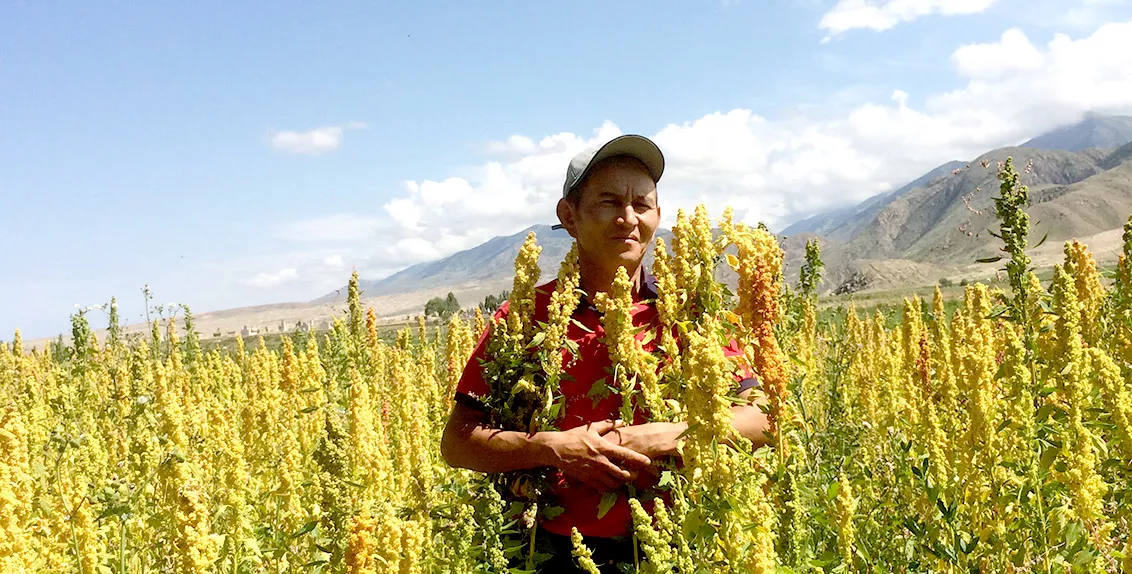Kyrgyz-grown quinoa makes its way into global markets
A few years ago no one knew about quinoa in Tong District in Kyrgyzstan’s eastern Issyk-Kul Region. But today the village of Bokonbaevo in the district is regarded as the birthplace of Kyrgyz quinoa cultivation.
The pioneer farmer who started growing quinoa in the area is 44-year-old agronomist Azamat Kaseev. His company AgroLead is a major producer of this super crop in the region. It all began in 2012 when he received first seeds of quinoa varieties "Regalona" and "Titicaca" from the Food and Agriculture Organization of the United Nations (FAO). It has taken him around five years to test and adapt the crop to local conditions.
"The yield of this crop is quite high; 2.5 kg of seed sown on one hectare of land can provide up to three tonnes of quinoa,” Azamat Kaseev says. With current global market prices ranging from 2 to 16 USD per kilogram, he hopes to make a handsome profit.
But FAO is not the only organization that promotes quinoa in the country. The International Center for Biosaline Agriculture (ICBA) has been introducing its own varieties of quinoa in Kyrgyzstan. In 2015, with the financial support of the Islamic Development Bank (IsDB), the seeds of five improved salt- and drought-resistant quinoa varieties from the ICBA’s gene bank were distributed to scientists and farmers in the country.
Since then quinoa has been sown in all regions of Kyrgyzstan: Chui, Talas, Jalal-Abad, Batken and others. Several years of experimentation has shown that Tong District of Issyk-Kul Region, Bakay-Ata District of Talas Region and the foothills of Jalal-Abad Region with certain temperatures, when it is hot in the day and cold at night, have the most suitable conditions for the crop. More and more farmers are also jumping on the quinoa bandwagon as the crop offers high profits.
But quinoa growers face various challenges. Harvesting and post-harvest processing are not fully mechanized yet. Azamat Kaseev literally generates his income by hand; all the work including sowing, weeding, cutting, drying and threshing is performed manually. “There is no mechanized equipment for cultivating and harvesting quinoa in Kyrgyzstan,” he complains.
Yet an even bigger challenge is to do with selling produce. Because of bureaucracy, he has not obtained yet a certificate of origin and a certificate of quality of the quinoa he grows. Therefore, he can only sell it in small quantities to buyers in Ukraine, some local farmers, as well as shops and restaurants specializing in organic food products. The retail price of quinoa goes up to 700 Kyrgyz soms per kilogram (1 USD is around 70 Kyrgyz soms), while seeds can fetch up to 2,000 Kyrgyz soms per kilogram.
Quinoa work is nonetheless making progress. Local researchers are also upbeat about the crop’s future in the country. For example, scientists at the Kyrgyz National University have developed various recipes and a beverage drink from locally grown quinoa. And a team of researchers at the National Academy of Sciences and the Kyrgyz National Agrarian University have even patented recipes for a quinoa-based drink and a quinoa-based muffin cake.
Thanks to Azamat Kaseev’s unwavering enthusiasm and capacity development events organized by ICBA scientists, dozens of Kyrgyz farmers have started cultivating the crop. Quinoa fields have expanded across Kyrgyzstan: 14 hectares on highlands in Issyk-Kul Region, and 56 and 80 hectares in Talas and Jalal-Abad regions. This is no mean feat given that only a few years ago quinoa was literally unknown in this Central Asian country.
